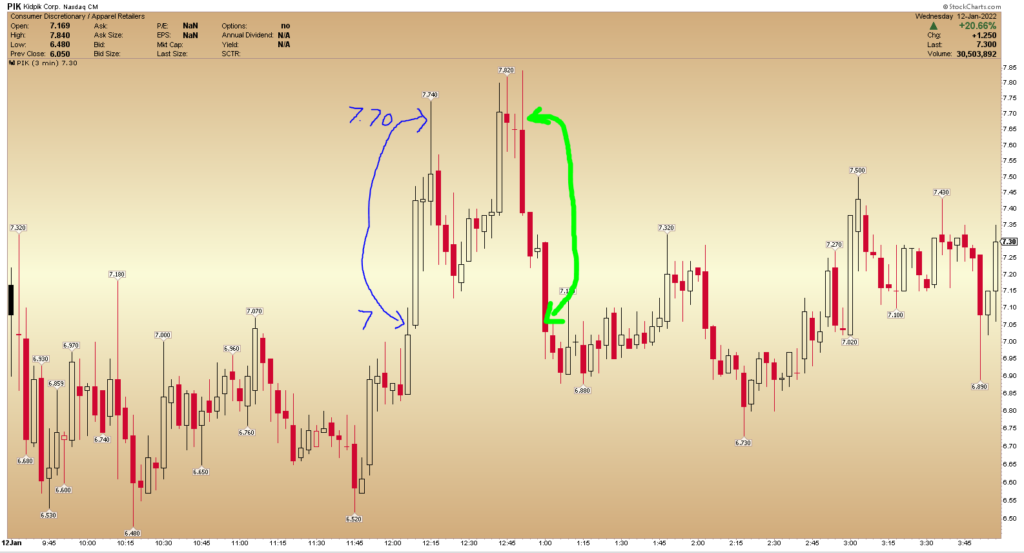I want to cover an interesting topic today, which I have not spoken much about in the past with you.
Short Selling.
You see, you and my members might know that I am predominantly a bull.
I have a handful of trusty, favored setups that I, time and time again, look to exploit in the market.
Such as the consolidation leading to a breakout pattern or the higher high, higher low setup, just to name a few.
But in recent times, I have also exploited opportunities on the short side.
As I have said before, It is essential to adapt to the various market cycles. For me, that has meant taking advantage of opportunities that presented themselves on the short side, every now and then.
Before I get into details, I must add that risk management always has to be at the forefront of my trading when I look to go short.
Why?
Well, the answer is pretty simple.
You see, stocks have limited downside, and stock can only go to $0. On the flip side, though, in theory, a stock has unlimited upside.
Therefore, if you are shorting a stock, therefore betting that it will go lower, your risk management needs to be in check because if you are wrong, the stock could have unlimited upside over time.
When I go short, gang, I always make sure I know exactly where I am wrong, what I am risking, and always respect my stop loss. That way, I do my best to stay out of trouble.
Alright, let’s get to business.
What is Short Selling?
Investopedia describes short selling as when an investor borrows a security and sells it on the open market, planning to repurchase it later for less money. Short-sellers bet on a drop in a security’s price and profit from it.
Ok, so if that is somewhat confusing, don’t worry, gang, I’ll put it in simpler terms.

Example 1:
For the sake of the below examples, let’s pretend that I traded PIK yesterday on the short side.
In the first example, using the blue line, I was short-biased and thought the stock would trade lower.
Because I am betting that the stock would go lower, I first need to secure shares to short the stock.
So I borrowed the shares and shorted the stock at $7. $7 is my entry price.
Because I have borrowed the shares, I now have to return the shares to the borrower at either a higher or lower price.
So if I shorted the stock at $7 and repurchased the shares at $7.70 to close out my position, my loss would be $0.70 per share.
The stock failed to trade lower, and as a result, I had to buy back the shares at a higher price to close my position, resulting in a loss.
Example 2:
Now in the second example, let’s flip the script.
Here, let’s say I got short the stock at $7.70 because I believed the stock had put in a short-term high and was bound to trade lower.
First of all, in terms of managing risk, I might have also placed a hard stop at the high of the candle to protect my downside and manage my risk appropriately.
In this example, I was correct, and the stock traded lower, and I covered the position at $7.
The profit per share is $0.70.
In this example, I borrowed shares at $7.70, thinking the stock would trade lower, and I would get to repurchase the shares for a lower price. The difference between where I got short and where I repurchased the shares and covered my position would represent a profit.
The Bottom Line
Gang, this is just an intro into the world of short selling.
I want to emphasize that firstly, short selling is not for everyone, and that’s ok! And secondly, as I said before, I always place massive importance on risk management when I go short.
There are many key concepts and variables that are important to consider and understand when deciding whether or not to go short.
As I said, this is just the tip of the iceberg on this topic, so be on the lookout in the future as I will dive deeper into the world of short selling.







1 Comments
Jeff,
I appreciate the explanation of going Short, but I really don’t get it. I’m very good with numbers, which is why I don’t get it. If I buy at $7.70 and sell at $7.00, how is that a profit for me? No matter how one looks at it it seems to me to be a $.70 cent loss per stock.
What is the missing part of this I don’t see?
Thanks in advance for your help.
Bill